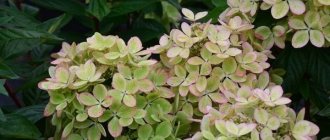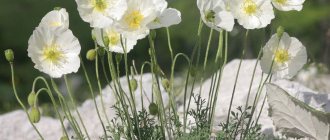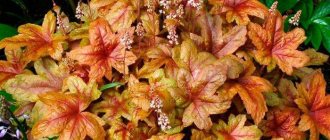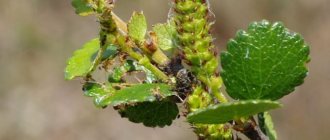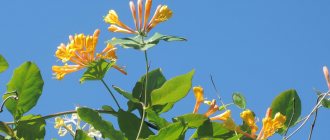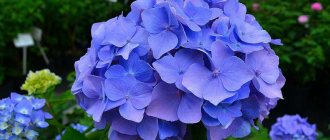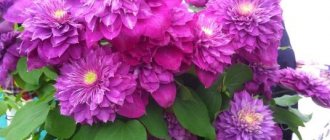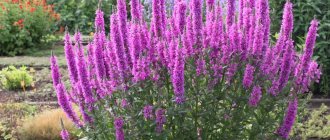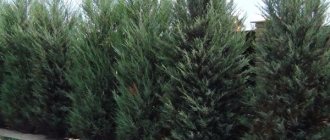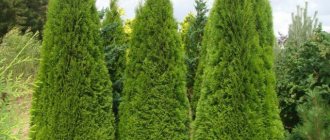Description of Thuja Holmstrup
Based on the description, Thuja occidentalis Holmstrup is an evergreen plant, similar to what can be seen in the photo. Although the height of adult specimens is 3 - 4 m, with a diameter of 1 - 1.5 m, these ornamental trees are characterized by low growth rates. To reach its maximum size, Thuja Holmstrup will need at least 10 - 12 years. The average age of this plant is close to 200 years.
Like most conifers, throughout the year Thuja Holmstrup retains the dark green color of the crown, which is characterized by density and has a symmetrical cone-shaped shape that can be preserved even in the absence of regular decorative pruning. The highly branched shoots are covered with soft scaly needles that do not fall off in winter. The root system of the plant is located in the upper layers of the soil and is compact.
Thanks to its excellent aesthetic qualities and ease of care, thuja variety Holmstrup is a favorite of many gardeners when creating exquisite landscape compositions.
Differences from other popular thuja varieties
Thuja Holmstrup is one of the most common types of western thujas in Europe and Russia, which are highly decorative, frost-resistant and undemanding in care.
The most popular in Russian summer cottages are the columnar thujas: Smaragd, Brabant, Columna and Holmstrup. Unlike its multi-meter counterparts - thuja Smaragd, Brabant and Columna - Holmstrup is a low shrub. By its 10th anniversary, it grows to 1.5-1.7 m, while having a crown with a diameter of 0.6-0.7 m. The annual growth of Holmstrup is 12-15 cm in height and up to 4 cm in width. By its mature age (200 years), it will reach 3-4 meters in height and a maximum crown diameter of 1.0 - 1.2 m. Such parameters allow Holmstrup to be classified as a narrow-columnar dwarf conifer species.
This thuja has an interesting fan-shaped arrangement of side shoots - “curly”, due to which the crown of this type of conifer is very thick and dense. However, even if you put your hand inside it, there is no risk of getting a scratch or abrasion: Holmstrup’s needles are very delicate and soft due to the special arrangement of the scales.
This is interesting: Thuja Hoseri occidentalis - description, planting and care
The use of thuja Holmstrup in landscape design
The characteristics of thuja occidentalis Holmstrup have been highly appreciated by landscape design masters in many countries around the world. This plant shows itself equally brightly in single and group plantings. In addition, dark green thuja can serve as an excellent background for other ornamental crops
Holmstrup thujas planted separately are used for landscaping urban landscapes, as well as for designing rockeries, alpine slides and lawns, as in the photo below.
A group of trees arranged in a row or forming a hedge, in turn, is perfect for creating natural fences that separate the functional areas of the garden. They are also used to mark the boundaries of a site, planted along the perimeter of the territory. This placement, in addition to being decorative, has another goal - air purification, since Thuja Holmstrup traps exhaust and heavy metals. For the same reason, it is located near industrial buildings and highways.
Advice! To create a hedge, trees of the Holmstrup variety must be planted, maintaining a distance of 50 cm between specimens.
A few more photos with examples of the use of thuja Holmstrup in landscape design:
Landing rules
Although Thuja Holmstrup cannot be called a whimsical plant, to ensure healthy growth and maintain its decorative characteristics, it is worth familiarizing yourself with the basic planting rules.
Recommended timing
The optimal time for planting thuja Holmstrup is considered to be mid-spring, when the likelihood of return frosts is minimal. Although this plant can boast of fairly high frost resistance, it should be planted in open ground no earlier than the end of April, so that the soil has time to warm up and the root system is not damaged. Dry, warm autumn is also suitable for planting thuja, but in this case the seedlings must be covered for the winter.
Important! Despite the fact that homestrup thuja can be planted at any age, it is best to choose young trees for this procedure, as it is easier for them to adapt to new conditions.
Site selection and soil preparation
The location for planting the western thuja variety Homestrup should also be chosen with the utmost care. It grows especially well in sunny places that are not exposed to drafts, but the culture also does quite well in slightly shaded areas. Too strong a shadow leads to the fact that the thuja needles begin to turn pale and the crown loses its density. Lack of sun also affects the health of the plant: its immunity weakens, and the tree becomes more susceptible to fungal diseases.
It is advisable to select light and loose soils for thuja Holmstrup, for example, sandy loam or turf in combination with peat and sand. In dense soil, drainage from 15 to 20 cm thick should be used to prevent stagnation of water and rotting of the roots.
Important! The acid level of soil for thuja Holmstrup should not exceed the range of 4 - 6 pH.
Landing algorithm
Planting of thuja western Holmstrup is carried out, guided by the following description:
- Before planting, a soil mixture of sand, lowland peat and leaf soil is prepared for the plant in proportions of 1:1:2.
- The planting hole is made slightly larger than the root part of the thuja Holstrup. Its approximate size should be 80x80 cm.
- It would be a good idea to place a drainage layer of broken brick or crushed stone in the recess.
- For intensive growth, nitrogen-phosphorus fertilizer is added to the soil at the bottom of the planting hole.
- Before planting, the seedling is generously watered.
- If the seedling has a closed root system, that is, a ball of earth around the roots is preserved, it is placed in a planting place, and then sprinkled with soil mixture so that the root collar is near the surface, and the soil around the plant is compacted.
- If a young thuja has an open root system, first prepare an elevation of soil in the center of the hole, and then place the tree on it, carefully straightening the roots. At the end of the procedure, the soil is compacted without filling the root collar.
After planting, the plant is abundantly saturated with water, and the soil within the tree trunk circle is mulched with sawdust, peat or mowed grass.
Advice! To ensure that water supplies the roots more efficiently and does not spread, an earthen mound about 5 cm high can be made around the trunk of the plant.
Rules for growing and care
Young Thuja Holmstrup trees require periodic weeding and loosening. When carrying out these procedures, it is worth remembering that the root system of such conifers is located close to the surface of the soil, and therefore when digging the soil deeper than 10 cm, it can be accidentally injured.
The rest of the care when growing these plants includes timely watering, regular fertilizing and pruning.
Watering schedule
The drought resistance of the western thuja variety Holmstrup allows it to survive for a long time with a small amount of water, however, a prolonged lack of liquid has a negative impact on the appearance of the plant. In order for the thuja to please the eye all year round, it is necessary to water it at least 1 - 2 times a week, allocating 10 liters of water per tree. During drought periods, watering is increased to 20 liters - 3 times a week.
Along with watering, you can sprinkle the plant 1 - 2 times a week. This procedure will not only refresh the crown of the conifer, but will also have a beneficial effect on its growth. But it is worth keeping in mind that it is carried out only on healthy thujas. Trees infected with fungal infections are not recommended to be moistened in this way.
Advice! To ensure that water reaches the roots better, and watering and loosening do not have to be done very often, the thuja tree trunk circle can be mulched with wood chips, sawdust or peat.
Top dressing
Thuja Holmstrup is fertilized once a year, usually in the spring, in April - May. Universal mineral complexes for conifers, such as Kemira-Universal or nitroammofoska, are used as top dressing, using 50 - 60 g of the composition per 1 sq. m. m of territory.
Important! The plant does not need to be fed for the next 2 - 3 years if mineral fertilizers were added to the soil during the planting process.
Trimming
To maintain the visual appeal of the thuja Holmstrup, it must be pruned from time to time. Sanitary pruning to remove dry and damaged branches can be done every year after winter. Decorative pruning is not required so often: it is enough to trim the plant once every 2-3 years.
A hedge of western thuja Holmstrup, such as the one in the photo above, is formed by cutting the shoots by a third. In the future, to maintain its shape, it is leveled 3 to 5 times a year.
Advice! In order for the trees to acquire the silhouette of a rounded cone, you can trim the upper branches of the plants when pruning.
Preparing for winter
Being plants of the third and fourth frost resistance zones, adult specimens of the thuja variety Holmstrup can easily tolerate even severe frosts down to -35 °C, so in central Russia they do not need shelter.
At the same time, young trees do not have such winter hardiness, so in the first couple of winters after planting they must be protected from frost using covering material. For this purpose, agrofibre or burlap is useful, which is used to wrap the crown of plants, leaving a small space between the material and the needles for air circulation. Additionally, you can mulch the thuja tree trunk with spruce branches: this will save it from waterlogging when the snow melts and protect it from rodents.
With the arrival of spring, as soon as the snow melts and the frosts end, the shelter from the thuja Holmstrup is removed. They do this in cloudy weather, and not right away. First, the agrofibre is raised by 1/3 and the plant is left in this form for 5-7 days so that it adapts. After the specified time, the protective material is completely removed.
Where, how and when to plant thuja
Thujas love good light, although they can grow in partial shade. For thuja Holmstrup, the lack of sun is expressed in the looseness of the crown, the loss of the shape given by nature, and the pallor of the needles. Therefore, the best place to plant it is sunny, but protected from cold winds and drafts.
The soil
Thujas love slightly acidic light soil with an acidity level of 4.5 -6.0 Ph, without a high groundwater level. When planting, it is necessary to ensure good drainage, for which a layer of at least 15 cm of brick fragments, crushed stone, and river pebbles is poured onto the bottom of the planting hole.
Landing
A layer of fertile soil is poured over 1/3 of the hole on top of the drainage layer.
This can be a mixture of sand, peat, garden soil in a ratio of 1:1:2. Water generously. After the water is absorbed, carefully release the plant from the container. Lower the seedling into the hole, trying not to disturb the earthen lump. Cover with the rest of the prepared soil. Water again, trying to shed the entire earthen lump. Carefully compact the soil around the seedling to remove all air voids in the planting hole. Mulch the root circle with mowed grass, bark or wood chips.
Important! The root collar must be at ground level!
Landing dates
Plants with a closed root system can be planted at any time. When planting in the fall, this must be done a month before persistent cold weather so that the seedling can take root.
It is preferable to plant thujas with bare roots in early spring, so that over the summer the plant can adapt and go into winter stronger. As a rule, such plants are difficult to take root and suffer for a long time if they are planted in summer, in hot weather, or in late autumn, shortly before frost. In order for such seedlings to survive, they need additional care.
Thuja Holmstrup is an unpretentious plant: it is drought-resistant, frost-resistant and little susceptible to disease. However, this does not mean that it should be abandoned on your site. A minimum of effort on your part, and she will thank you by creating a zone of beauty and health!
Watering
Thujas love moist soils; lack of moisture negatively affects their appearance: the needles become limp and crumble. In summer they are watered 2 times a week; one plant needs at least 7-10 liters of water. Thujas are very responsive to sprinkling, which is recommended to be done regularly in hot weather. After such a shower, the air at a distance of up to 4 m will be filled with the aromas of a coniferous forest!
Thujas evaporate a lot of moisture, so you need to create conditions to maintain the moisture around the trunk.
- around the trunk along the diameter of the crown, sides are formed to prevent water from spilling - the so-called “saucer”;
- After each watering, mulch the tree trunk circle.
Feeding
For thuja, it is very important to follow the principle: “It is better to underfeed than to overfeed!” This especially applies to an excess of nitrogen: it initiates rapid growth of the plant, due to which its decorative effect is sharply reduced: the crown becomes loose, long thin branches do not cover the trunk
Thuja looks “disheveled” and unkempt.
Plants with a closed root system are not fed during the first year after planting, since the planting soil already contains fertilizers for long-acting conifers.
In order not to make a mistake with the dose and time of fertilizing, it is better to use special fertilizers for conifers. They come in 2 types: spring and autumn. Autumn ones are dominated by potassium and phosphorus, which help the thuja prepare for winter.
Preparing for winter
The originators of the thuja variety Holmstrup claim that the shrub survives even in the 3rd climate zone! In practice, this thuja can withstand frosts down to 25-30 degrees.
The roots of the plant, which are located at a shallow depth of up to 10 cm, suffer most from low temperatures. Therefore, the main pre-winter care consists of mulching the tree trunk circle with leaf litter and small branches in a layer of at least 20 cm. It is advisable to put burlap on top - it will protect the plant from rodents. A layer of snow on top of this shelter will create additional protection from severe frosts.
To prevent the shrub from breaking during heavy snowfalls, it is recommended to tie the thuja tightly with a wide ribbon of natural material or cover it with burlap - such a cover will protect the needles from burning out in the spring sun.
Pests and diseases
Although Thuja Holmstrup is resistant to most diseases, it is sometimes attacked by certain insects that damage the plant's needles. These include thuja aphids and false scale insects.
Due to their activity, the crown of the tree acquires a yellowish tint and falls off. Various insecticides have proven themselves to be effective against these pests; they must be used to treat the plant twice, maintaining a gap of 7 to 10 days between treatments.
The root system of young thuja Holstrup trees is often encroached upon by the larvae of cockchafers. Having discovered this insect on the site, do not underestimate the danger it can cause: even one larva of the cockchafer can destroy a conifer seedling in 24 hours. You can save plants from this scourge if you water it with a solution based on Imidacloprid.
As for diseases, with proper care they do not threaten thuja Holmstrup trees. However, if the watering schedule has been disrupted, the thuja variety Holmstrup can be affected by fungi, which will cause the branches of the plant to dry out. Regular watering and treating trees three or four times with compounds containing copper will help correct the situation. Similar treatments are carried out every 2 weeks until the condition of the thuja Holmstrup returns to normal.
Reviews
According to gardeners' descriptions, Thuja Holmstrup perfectly maintains its cone-shaped shape, acquiring it naturally as it grows, and therefore requires minimal shaping.
Most call caring for it completely easy. The main attention should be paid to proper watering and mulching.
What do you associate a dacha with? What about your children? Do you want it to be more than just a sore back, mosquito bites and broken nails? Then say only one word - thuja!
You feel - instead of the smell of manure, you immediately smelled fresh pine needles, heated in the sun... The children have built a hut among the thick, tender branches... The husband is in the chair reading the newspaper and not a single blood-sucking creature attacks him... And you are just taking a break from worries, glancing over the crown of the “tree of life” " And weeding an endless garden bed no longer seems impossible, one can talk about a modest harvest with humor, and the curious glances of neighbors do not penetrate the hedge...
